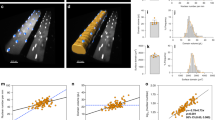Summary
In the 3-, 33- and 66-day-old chicken, two muscles, the oxidative slow tonic anterior latissimus dorsi and the glycolytic fast twitch posterior latissimus dorsi were compared by the measurement of muscle fibre diameter and the fraction of total muscle tissue nuclei which were either myonuclei or satellite cell nuclei. Between 3 and 33 days there was a period of rapid growth (more marked in the posterior latissimus dorsi) which coincided with a sharp fall in numerical density of myonuclei and satellite cell nuclei (number per cubic millimetre muscle tissue). The fraction of all nuclei which were satellite cell nuclei declined steadily.
The higher levels of myonuclei and satellite cell nuclei in the anterior latissimus dorsi were thought to be a reflection of its oxidative metabolism and the presence of multiple endplates.
The volume of sarcoplasm occupied by single myonuclei in anterior and posterior latissimus dorsi muscles was shown to be considerably greater than that occupied by nuclei in other cell systems.
Similar content being viewed by others
References
Allbrook DB, Han MF, Hellmuth AE (1971) Population of muscle satellite cells in relation to age and mitotic activity. Pathology 3:233–243
Aloisi M, Mussini J, Schiaffino S (1973) Activation of muscle nuclei in denervation and hypertrophy. In: Kakulas BA (ed) Basic Research in Myology. Excerpta Med Int Congr Ser 292:338–345
Bedi KS, Cope GH, Williams MA (1974) An electron microscopicstereologic analysis of the zymogen granule content of the parotid glands of starved rabbits and of change induced by feeding. Arch Oral Biol 19:1127–1133
Bishop ON (1971) Statistics for biology. 2nd edition Longman London
Bolender RP (1974) Stereological analysis of the guinea pig pancreas. I Analytical model and quantitative description of the nonstimulated pancreatic exocrine cells. J Cell Biol 61:269–287
Campion DR, Marks HE, Richardson LR (1982) An analysis of satellite cell content in the semimembranosus muscle of Japanese quail (Coturnix coturnix japonica) selected for rapid growth. Acta Anat 112:9–13
Gibson MC, Schultz E (1983) Age related differences in absolute numbers of skeletal muscle satellite cells. Muscle Nerve 6:574–580
Ginsborg BL, MacKay B (1960) The latissimus dorsi muscles of the chick. J Physiol 153:19–20P
Hess A (1961) Structural differences of fast and slow extrafusal muscle fibres and their nerve endings in chickens. J Physiol (Lond) 157:221–231
Kelly AM (1978a) Satellite cells and myofiber growth in the rat soleus and extensor digitorum longus muscles. Dev Biol 65:1–10
Kelly AM (1978b) Perisynaptic satellite cells in the developing and mature rat soleus muscle. Anat Rec 190:891–904
Mauro A (1961) Satellite cells of skeletal muscle fibres. J Biophys Biochem Cytol 9:493–495
Moss FP, Leblond CP (1971) Nature of dividing nuclei in skeletal muscle of growing rats. J Cell Biol 44:459–462
Reith A (1973) The influence of triiodothyronine and riboflavin deficiency on the rat liver with special reference to mitochondria. Lab Invest 29:216–228
Schmalbruch H, Hellhammer U (1976) The number of satellite cells in normal human muscle. Anat Rec 185:279–288
Schultz E (1974) A quantitative study of the satellite cell population in post-natal mouse lumbrical muscle. Anat Rec 180:589–596
Shapiro SS, Wilk MB (1965) An analysis of variance test for normality (complete samples). Biometrika 52:591–611
Shear CR, Goldspink G (1972) Structural and physiological changes associated with the growth of avian fast and slow muscle. J Morphol 135:351–372
Snow MH (1977) The effects of aging on satellite cells in skeletal muscles of mice and rats. Cell Tissue Res 185:399–408
Snow MH (1978) An autoradiographic study of satellite cell differentiation into regenerating myotubes following transplantation of muscles in young rats. Cell Tissue Res 186:535–540
Snow MH (1981) Satellite cell distribution within the soleus muscle of the adult mouse. Anat Rec 201:463–469
Sokal RR, Rohlf FJ (1981) Biometry. 2nd ed W.H. Freeman and Co San Francisco
Weibel ER (1979) Stereological methods Vol 1 Practical methods for biological morphometry. Academic Press, London
Weibel ER, Stäubli W, Gnägi HR, Hess FA (1969) Correlated morphometric and biochemical studies on the liver cell. I Morphometric model, stereologic methods and normal morphometric data for the rat liver. J Cell Biol 42:68–91
Yorita T, Nakamura H, Nonaka I (1980) Satellite cells and muscle regeneration in the developing dystrophic chicken. Exp Neurol 70:567–575
Author information
Authors and Affiliations
Rights and permissions
About this article
Cite this article
Matthew, C.A., Moore, M.J. Numbers of myonuclei and satellite cell nuclei in latissimus dorsi muscles of the chicken. Cell Tissue Res. 248, 235–238 (1987). https://doi.org/10.1007/BF01239987
Accepted:
Issue Date:
DOI: https://doi.org/10.1007/BF01239987




